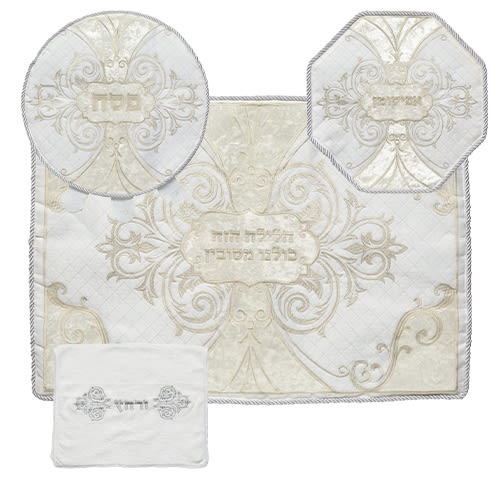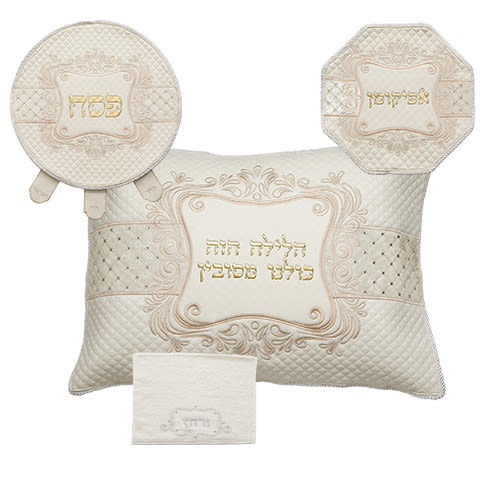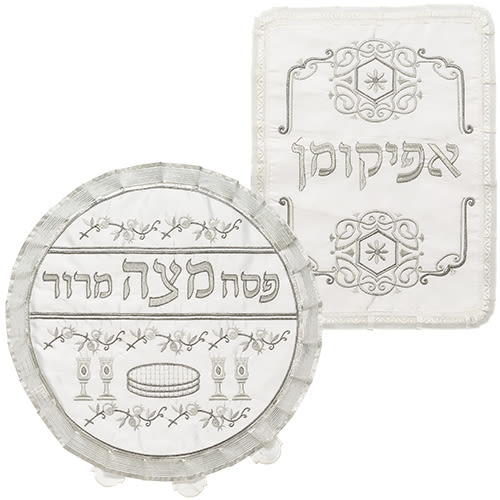
Steps to Freedom
At this moment all you will receive is a humble vegetable dipped in salt water. If you can swallow this surprise and continue, even though you did not...

At this moment, all you will receive is a humble vegetable dipped in salt water. If you can swallow this surprise and continue, even though you did not receive anything substantial – don’t worry; in the end a kingly feast awaits you.
The Simanim
The night of Pesach
The Seder night is a night of rejoicing in the redemption, a night of praise and thanksgiving to the Creator. The Seder is composed of fifteen steps, called simanim. They are:
1. Kadesh, Kiddush
2. Urchatz, Washing
3. Karpas, Greens
4. Yachatz, Breaking
5. Magid, Telling
6. Rachtza, Washing
7. Motzi, Blessing
8. Matzoh, Matzah
9. Maror, Bitter Herbs
10. Koreich, Sandwich
11. Shulchan Orech, A Full Meal
12. Tzafun, Dessert
13. Borech, Grace After Meals
14. Hallel, Praise
15. Nirtzah, Acceptance.
Reb Nosson explains that these simanim, as well as and all our actions on this holy night, are “trail guides” or steps on the ladder that brings each of us to personal freedom. In addition to commemorating our redemption from Egypt, the mitzvot of the seder are tools for attaining freedom. Learning about these simanim will teach us the route of our final redemption and what we can expect to encounter on the way (Likutei Halachot).
1. Kadesh
We begin the seder by making Kiddush to sanctify the day. At the seder, every Jew should drink four cups of wine corresponding to the four expressions of freedom mentioned in the Torah (Shemot 6: 6-7), and Kiddush is the first of those four cups of wine.
In the Lecha Dodi prayer recited on Friday nights, we say: “Last in deed but first in thought.” Our first thought should always be — what will be in the end? What is the purpose?
At the beginning of the seder, as we embark on our spiritual quest, we look to the ultimate purpose. The goal of our deeds and the events of our lives is—kadesh – to be sanctified!
Our purpose in life is to become holy. “You shall be to Me a kingdom of ministers and a holy nation” (Shemot 19:6). “You shall be holy, for holy am I, Hashem, your God” (Vayikra 19:2).
Through working on ourselves and keeping the mitzvot, we are meant to change ourselves from materialistic, petty-minded beings and become holy. Being holy means to be able to rise above our physical desires, detach ourselves from selfish considerations, and desire eternal values.
In the words of Reb Nosson: “The purpose of the entire Seder is to open the mind, to proclaim that Hashem is God, and to merit an enlightened desire… meaning, at the time we are eating we will merit to have the desire and longing for closeness to God with all our heart” (Likutei Halachot, Orech Chaim, Hilchot Netillat Yadaim 6).
2. Urchatz, Washing the hands
The goal is holiness. The first step toward holiness is to wash – to wash ourselves of our materialism! To become holy, we must detach ourselves from physicality. We must purify our deeds and not just think uplifting thoughts.
The hands are unique in that they touch the world and take action. Therefore, hands symbolize action. We purify them with water. Netillat yadaim — washing, or more literally, lifting the hands — symbolizes removing all traces of materialism that cling to the hands – our actions. Water is the purifying agent, because it symbolizes knowledge and change. Water is constantly changing and moving. Water brings life and purity.
But we do not make a blessing at this time. That will be possible later, during rachtza.
3. Karpas, Greens
Karpas is a vegetable (other than bitter herbs) such as celery, parsley, or boiled potato. We dip it in salt water, make the blessing “Borei pri ha’adama” and eat a small amount.
Once we understand that the purpose is to sanctify ourselves (kadesh), and begin purifying ourselves (urchatz), we need to remember to be satisfied with a small amount, as symbolized in that tiny bite of karpas.
If you thought that the moment you begin to serve God you would sit down to a kingly feast; if you imagined that the gates of Heaven would open up and you would be showered with understanding—you were in error!
At this moment all you will receive is a humble vegetable dipped in salt water.
If you can swallow this surprise and continue with the Seder, even though you did not receive anything substantial — don’t worry; in the end a kingly feast awaits you.
This important principle – being satisfied with little – demonstrates that we should not to expect immediate results in our spiritual quest. We must not be disappointed with what appears to be sparse results. This is the foundation of our entire avodat Hashem, Divine service. To attain the necessary humility and submissiveness for true avodat Hashem, we must first understand and take to heart this important concept.
Actually, even this “little” is a lot! It comes from God’s kindness! The karpas is a simple vegetable, but in the Megillat Esther, the world karpas refers to expensive silk garments.
4. Yachatz, Breaking
We break the middle matzoh into two pieces and save the larger piece for the afikomen, the dessert.
We have begun our spiritual quest and have attained the qualities of patience and of being satisfied with little. Now, the real work awaits us!
Avodat Hashem, Divine service, begins with breakage—yachatz! We save the broken piece for the afikomen, which we enjoy at the “end of the story;” nevertheless, breakage is breakage. Is anyone looking to be broken? Does anyone really comprehend the principle of shevira, breakage and tikun, rectification?
We break the matzoh, which is made of wheat flour. What does this represent?
How do we attain flour? We start with a whole seed kernel, closed and sealed, containing the germ of life. This seed, however, is useless as is. To utilize its potential, the seed must first be broken down within the earth.
This temporary breakage results in the wondrous stalks of grain, containing thousands of new duplications of the original seed. Then, we take this temporary “completion” and cut it down, separating the straw from the kernels of wheat. We winnow and sift the kernels and grind them into the flour—a new “completion.”
After that, we mix the flour with water, knead dough, and bake it in the oven. The flour has reached a new level of completion; it is the staff of life—bread. We take this level of completion, slice it and “break” it down once more with our teeth and digestive system. Only when the kernel of wheat has reached the point where it provides a human being with energy for his avodat Hashem has it reached its ultimate tikkun.
Just as bread—the staff of life—goes through this process of shevira and tikun, so too, we must pass through these steps before we reach our ultimate completion.
This is the secret of yachatz. We have to courageously accept that to reach perfection, we must first be broken. The seed releases its potential when it undergoes a temporary loss of completion, and progresses through the steps—stalks of grain, flour, bread, and life for man. We have to overcome the fear of temporarily losing our wholeness, and accept the breakage in love, with the awareness it is the key to release our potential—the goodness and holiness that exists within us.
5. Magid, Telling
On the seder night, we use our gift of speech for the central part of the Haggadah: the positive commandment of telling the story of the Exodus. As Jews, the gift of speech is the main tool we have for creating holiness and building ourselves.
A Jew must continually speak in holiness, praising God’s greatness, just as we do on the seder night. A Jew accomplishes this through reciting blessings, prayer and Torah study.
“The voice is the voice of Yaakov (Jacob)” (Bereishit 27); this means that the Jew’s power is in his mouth. God created the entire universe with words, when He said: “Let there be light.” We create our world with the holy words we speak.
Our words are not just sounds that express an idea. Our words are not just a means of communicating. There are far more than that. The inner content of all things—their neshama; their soul—is the spoken word, as mentioned in the holy works of Kabbalah. The very word “Pesach” is a contraction of the words peh sach, meaning, “the mouth speaks.” Our mouth opens and we speak words of holiness.
6. Rachtza, Washing
We wash our hands as a preparatory step before the Matzah, as we do before eating bread the entire year. This time, we wash with a blessing. We have progressed…
But we already washed, during urchatz. This symbolizes that we purified ourselves for holiness. Why do we wash and purify ourselves again?
Rebbe Nachman reveals there is a concept known as “teshuva on teshuva,” repentance on repentance (Likutei Moharan, Torah 8).
After we have repented, returned in teshuva, purified and rectified ourselves, and maintained a level of holiness, continually learning and progressing, we look back at our original teshuva and realize that it was insufficient, with flaws and ulterior motives. Now that we are on the ladder that leads to Heaven, from our new, more elevated perspective above, we see things in a new light. Our appreciation of purity and holiness has matured.
For this reason, precisely because we have accomplished the purity of urchatz, we return and see the need for rachtza, to purify ourselves in a more lofty way. We do “teshuva on our teshuva,” and because we are even more elevated, we can now recite the blessing.
7. Motzi, Blessing and 8. Matzoh, Matzah
After the double purification of urchatz and rachatz, after breakage and rectification, and after saying the holy words of maggid, we have made strides in our avodat Hashem, and we begin to uncover the hidden, true goodness.
Motzi matzoh literally means the Matzah comes out. Matzah symbolizes the purified, holy part, which is now revealed.
In the wonderful story “The Prince and the Precious Stones,” Rebbe Nachman hints at this process: “Once the prince was chopping wood and he cut his finger. The princess wanted to bandage his finger and she discovered there a precious jewel.” (Previously in the story a tzaddik had promised the king he would have a son who was made entirely of jewels). The Breslover chassidim would always explain this point of the story with the saying: “You only find the diamond when you bleed.”
When we serve God with all our might and with true self-sacrifice, we reveal the “diamond,” the inner goodness and holiness within. The “Matzah” comes out.
9. Maror, Bitter Herbs
We have already had some bitterness, but there is a little more…
Rebbe Nachman told a tale:
Once a Jew lost all his possessions and joined up with a gentile partner to wander from town to town and collect handouts. They arrived in a small town, exhausted and hungry, on the eve of Pesach. The Jew instructed the gentile about the Pesach customs so he could pretend to be a Jew, and told him to follow him to the synagogue where they would receive an invitation for the seder. However, he forgot to tell the gentile about maror.
That evening they were invited to separate homes. The gentile was doing well; he washed, ate a little bit of karpas, and listened to the Haggadah. By this time he was starving, and when they gave him the matzoh he hungrily wolfed it down. Now they were finally getting somewhere, he thought. According to his Jewish friend, coming up next would be fine delicacies, meat, and wine!
Instead, however, he was given a generous helping of strong horseradish for maror. He gulped it down, thinking it was a special delicacy. His mouth on fire, he angrily fled the house, cursing the Jews who played such a trick on him. “After waiting all this time this is what they give me!”
Hungry, disappointed and bitter, he waited for his friend in the synagogue. Well after midnight the Jew appeared, satiated and in good spirits. After hearing his friend’s bitter complaint the Jew remarked: “You fool, if you’d only waited a little more you would have had a royal feast like me!”
We need a little more patience and then we will reach the great feast. But first, we have to partake of a little maror. Reb Nosson explains:
“We have to bear bitterness in a number of ways… many have obstacles in finding truth, problems with their livelihood, bodily sufferings, confusions…
“Someone who will bear this bitterness to save himself from punishment for his sins will have peace, inner peace and peace with the entire world… He must have faith that God sends the bitterness in His mercy and forgives all his sins. He sends the bitterness only according to what the person can bear, and not as much as his sins warrant. This is the symbolism of dipping the maror into charoset (a pasty mixture of nuts, dates, apples, wine and cinnamon)” (Likutei Halchot, Hilchot Betziat HaPat, 8).
Bitterness is accompanied with great kindness; it is reduced to what we can bear, and sweetened with the charoset [during the Seder, we dip the maror in charoset before eating it]. We must try to “remain seated” at the “table” and not flee at the sight of maror, because the meal is soon to follow…
10. Koreich, Sandwich
The Hillel Sandwich is broken Matzah held together by bitter herbs and charoset.
The good (Matzah) and the bad (maror) are still intermingled within us. We have not yet reached the ultimate completion. We have to remember this before we can enjoy the final fruits of our labor (the Shulchan Orech, the Yom Tov meal).
11. Shulchan Orech, A Full Meal
We fulfill the Festival mitzvah by eating a festive meal.
Even in this world we have the opportunity to taste the sweet spiritual enjoyment that is reserved for the righteous in the World to Come.
12. Tzafun, Dessert
The last thing we eat is the Afikoman.
Back at the beginning of our quest we broke the Matzah, and now we enjoy the results. This reminds us of the final end, our hope for the future and the soul’s eternity.
13. Borech, Grace After Meals and 14. Hallel, Praise
When we taste the goodness of our spiritual attainments, what else is there for us to do besides express our thanks and praise?
15. Nirtzah, Acceptance
If we pass through all the steps successfully and continue our quest onwards we will assuredly reach the good ending that is beloved before the Creator.
Nirtzah does not just represent that our seder was acceptable to God; rather, it teaches that we have reached the pinnacle—the quality of ratzon, the desire for closeness with God (nirtzah and ratzon share the same root: ratzah, to want or desire). All the ups and downs we experience in our life are intended to strengthen our desire for holiness.
We experience two basic situations in life: ups and downs, light and darkness, and both situations threaten our willpower for holiness.
In the “up” mode, when we are successful and progress well, we are in danger of becoming arrogant. Under the influence of arrogance we are likely to feel we have “made it,” and lose the desire to grow.
Rebbe Nachman writes: “If he thinks he is already close to God, and he has knowledge of God—this is a sign he knows nothing. For if he knew a little about God, he would realize how far he is from Him” (Likutei Moharan 63).
And so we say to the one who is striving: “Keep up your desire!” There are an infinite amount of spiritual levels left to attain.
In the “down” mode, when a person has stumbled, he is in the danger of despair. He no longer seeks to grow because of his fall; he gives up hope.
As Rebbe Nachman writes: “There are people who are on the lowest level, until they totally despair of themselves, God forbid. They imagine they are far from God and have lost all hope of eternity. The tzaddik must have the ability to arouse them and wake them up, so that they will not despair whatsoever. He must show them that God is still close to them, even as lowly as the earth… for God’s glory is even there, as it is written: ‘The whole world is filled with His glory’” (Likutei Moharan II, 7).
And so we say to the one who has fallen: “Keep up your desire! You also have hope; you have a chance. Don’t give up!”
If we fight this battle courageously, and continually desire God’s closeness, whether in our ups or downs, then we will actualize the holiest inner part of our soul: the ratzon.
Nirtzah is the name given to the one who is accepted by God, because he constantly desires God’s closeness.
If we follow the Seder, with its ups and downs, breakage and rectification, and continually desire to grow, it will be acceptable before God, and we will undoubtedly reach our final tikun.
***
(From: www.levhadvarim.com)











3/25/2010
Wonderful article, many thanks! i really enjoyed this article and look forward to sharing some of these insights at the Seder.
3/25/2010
i really enjoyed this article and look forward to sharing some of these insights at the Seder.